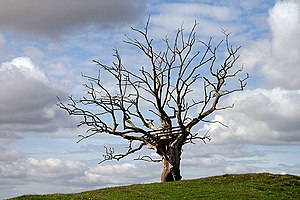 While the emerald ash borer has been the big tree pest to capture headlines in recent years, it certainly isn’t the only thing that has done damage to local trees. Dutch Elm Disease has ravaged elm trees in North America since the 1920s, killing huge numbers of American Elm trees. The disease was first discovered in Eastern Canada in the 40s and decimated a vast majority of the elm trees in its wake over the next several decades. Quebec has few of these majestic trees left and Toronto saw about 80% of its elm trees infected and hence destroyed. One of the few intact stands of elm trees lie in Alberta and British Columbia, due to aggressive preventive measures.
While the emerald ash borer has been the big tree pest to capture headlines in recent years, it certainly isn’t the only thing that has done damage to local trees. Dutch Elm Disease has ravaged elm trees in North America since the 1920s, killing huge numbers of American Elm trees. The disease was first discovered in Eastern Canada in the 40s and decimated a vast majority of the elm trees in its wake over the next several decades. Quebec has few of these majestic trees left and Toronto saw about 80% of its elm trees infected and hence destroyed. One of the few intact stands of elm trees lie in Alberta and British Columbia, due to aggressive preventive measures.
Dutch Elm Disease

A large English Elm infected with Dutch Elm Disease at West Point, NY June 2010 (Photo credit: Wikipedia)
What exactly causes Dutch Elm Disease though, you might wonder. Dutch Elm disease is a fungal infection spread by the elm bark beetle. Elm bark beetles burrow into infected trees and reproduce just under the bark. When the new beetles emerge the following spring, spores from the infected tree cover them. As they move to healthy trees, they continue the spread. In an attempt to stave off the fungal infection, the tree plugs up its xylem tissues. The problem with that is that water and nutrients also spread throughout the tree via its xylem tissues, so in effect the tree starves itself, causing its eventual death.
So what do you look for, if you have concerns for your elm tree? Some of the earliest signs of infection are wilted and yellowing leaves early in the summer, long before autumn leaf drop (June and early July). As the elm becomes further infected, wilting spreads throughout the tree. While the brown leaves stay on the tree during earlier infections, later infections show early leaf drop. A cut cross-section of a branch also shows a brownish-streak in the vascular tissues. The sad news is that a tree will often succumb to Dutch Elm Disease within a season or two.

If you have an elm tree and are concerned about it, feel free to contact CLC Tree Services. We have been in the tree care industry for over 25 years and have seen our fair share of disease and insect infestations. We will gladly do what we can for your elm trees to make sure that you enjoy them now and into the future.

